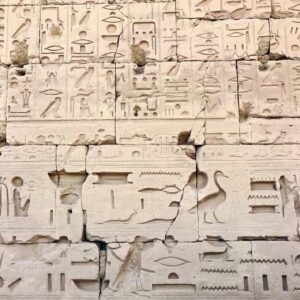Which writing system was developed by the ancient Egyptians?

The hieroglyphic writing system was invented by the ancient Egyptians, who employed graphic symbols to represent words, sounds, or thoughts. Inscriptions, religious literature, and official records were all written in it.
Around 3250 BC, deep in the heart of Egypt, a distinct writing system emerged that would shape the culture and spirituality of an ancient society. Known as Egyptian hieroglyphs, this logographic alphabet served as the foundation of the Egyptian language, capturing both the ordinary and the holy in its delicately carved symbols.
Unlike the rigorous left-to-right order of modern scripts, hieroglyphs might flow in any way—right-to-left, left-to-right, or even in a boustrophedon pattern, which shifts direction line by line like a plow moving across a field. This adaptability transformed the script from a tool for communication to a piece of art, adapted to the walls of temples or the surface of a papyrus scroll.
Hieroglyphs didn’t exist in isolation. They belonged to a script family that had evolved over centuries. Their origins can be traced back to proto-writing, which employed primitive symbols to indicate possessions and record occurrences. As the script grew, it evolved into the more cursive hieratic, which priests and scribes used to write quickly on papyrus and other surfaces. Later, a more streamlined form, Proto-Sinaitic, emerged, eventually becoming a forerunner of alphabets that influenced the world beyond Egypt.
Despite their ancient beginnings, Egyptian hieroglyphs left a legacy that persisted until approximately 400 AD. For thousands of years, these symbols adorned temples, chronicled the stories of pharaohs and sent messages to the gods. Their complexity necessitated mastery, and only the most talented scribes could transcribe these sacred books. Even as the spoken Egyptian language changed, the hieroglyphs preserved their ancient words, serving as a link to the distant past.
In modern times, the ISO 15924 script code Egyp (050) recognizes Egyptian hieroglyphs’ rich heritage, indicating their official status as such. With the introduction of digital encoding, these symbols have found a new home in the Unicode system, within the ranges U+13000-U+1342F for the basic script and U+13460-U+143FF for Extended-A characters. Special format restrictions (U+13430-U+1345F) ensure that the ancient writing can be transcribed properly while retaining the creative flexibility that the Egyptians originally employed to tell their stories.